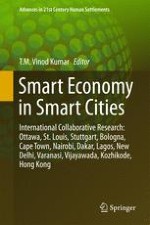2017 | OriginalPaper | Buchkapitel
24. Smart City Foundation, the Core Pillar for Smart Economic Development in Nairobi
verfasst von : Dennis Mwaniki
Erschienen in: Smart Economy in Smart Cities
Verlag: Springer Singapore
Aktivieren Sie unsere intelligente Suche, um passende Fachinhalte oder Patente zu finden.
Wählen Sie Textabschnitte aus um mit Künstlicher Intelligenz passenden Patente zu finden. powered by
Markieren Sie Textabschnitte, um KI-gestützt weitere passende Inhalte zu finden. powered by
